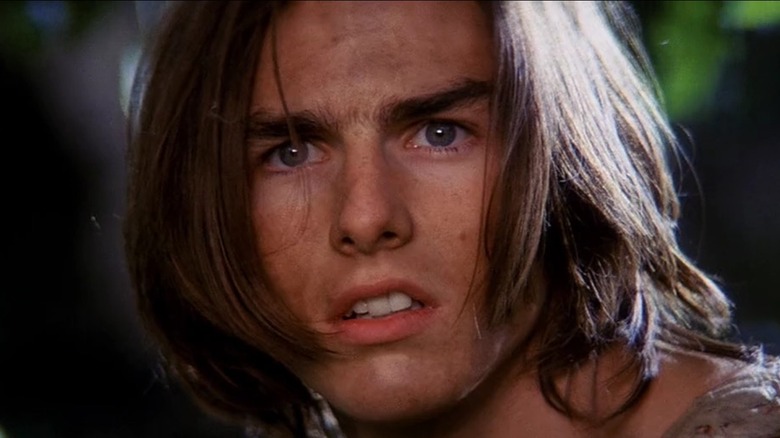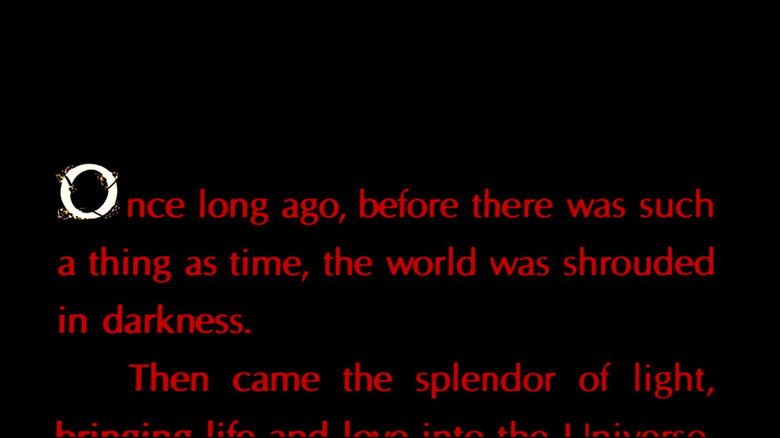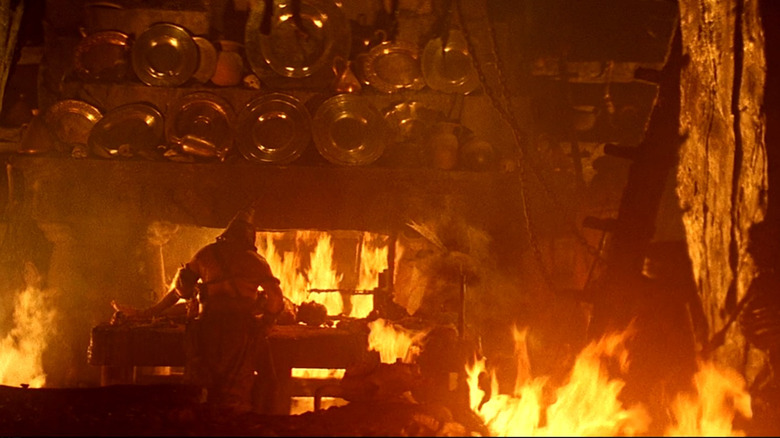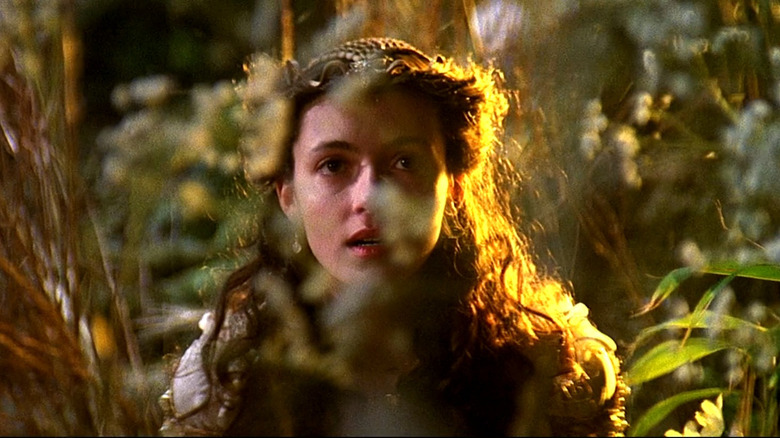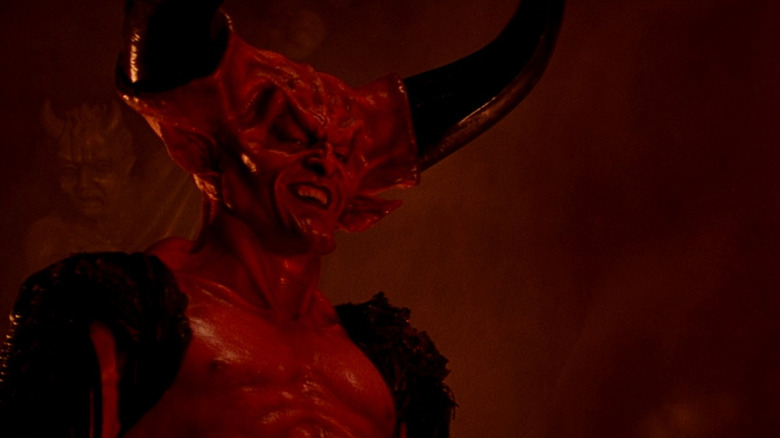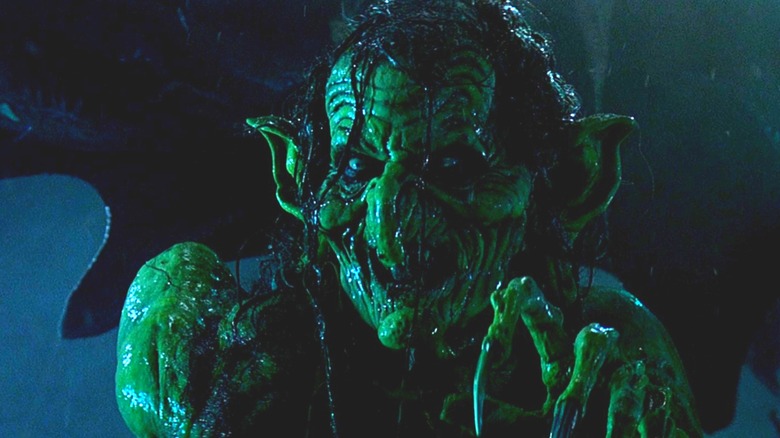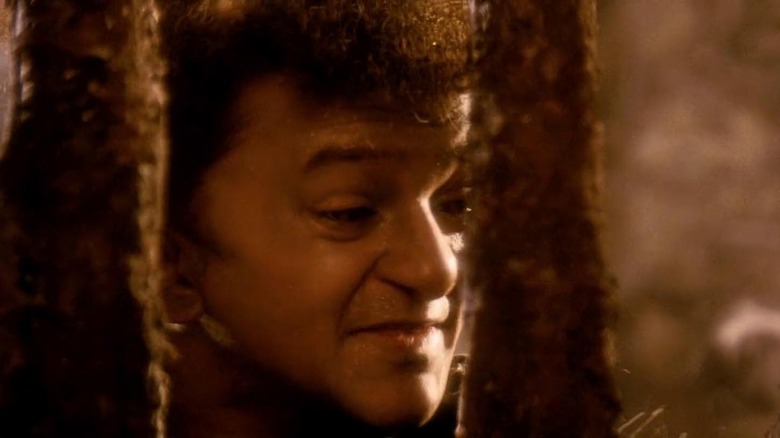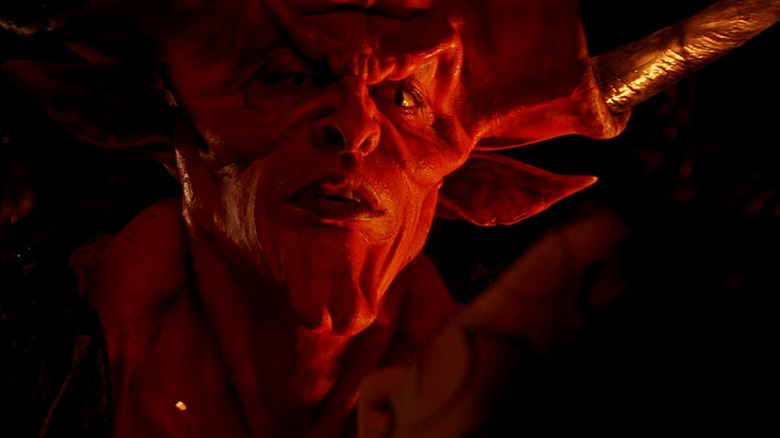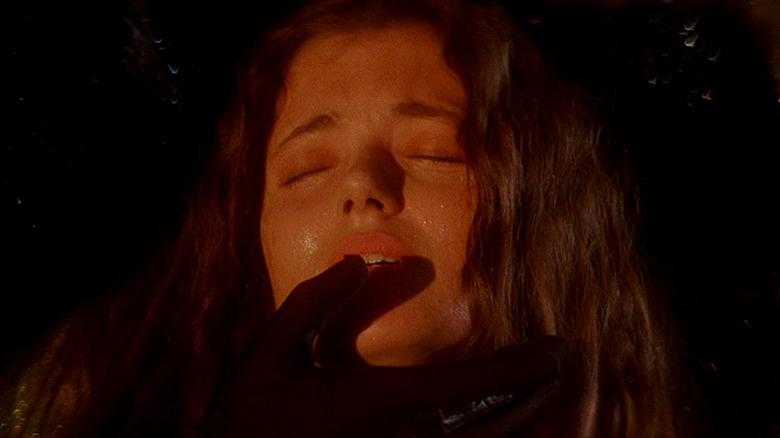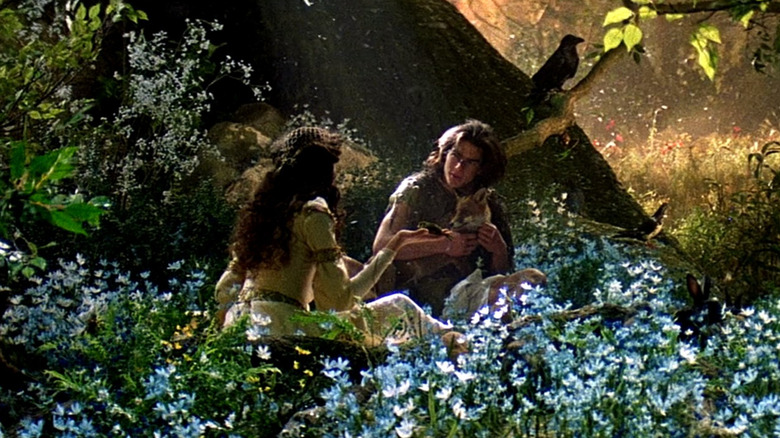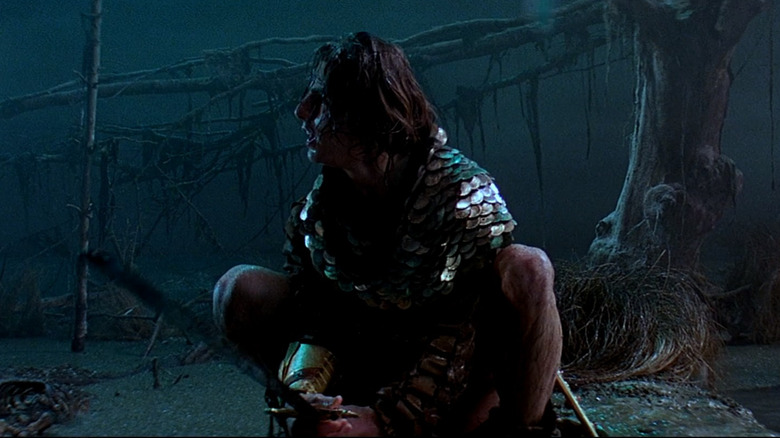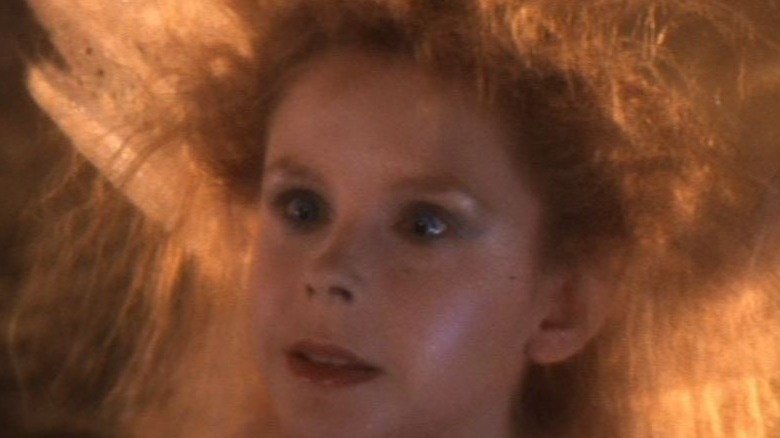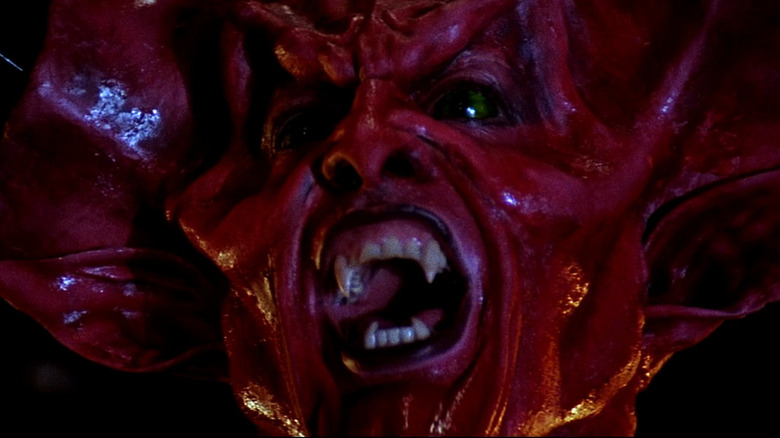Things About Legend Only Adults Notice
We live in a world where not many things are forgotten. As the media conglomerates dig in and go to war for our attention and monthly subscription fees, there's very little original entertainment from the past that hasn't been remade, rebooted, or continued in a sequel set decades later. Nostalgia has become as dominant a force as originality, since we can watch practically anything that's ever been made.
The most interesting artifacts of the past are the rare shows or movies that left a memorable impression, but haven't yet been dug up and given a fresh coat of paint, like 1985's fantasy epic "Legend." The movie was a high-profile riff on fairy tales directed by a red-hot Ridley Scott, who was coming off of "Blade Runner" and "Alien," two movies that remain hugely popular today with a multitude of sequels. But despite Scott's presence and the star-wattage of a young Tom Cruise, who was riding the success of "Risky Business," "Legend" flopped at the box office, as well as with those who did see it, after a lot of studio tinkering with the final product. The film now has a quiet cult following, consisting mostly of adults who wonder if it might've been something they dreamed up. These are the things you notice about "Legend" when you re-watch it as a grownup.
The opening crawl is more confusing than illuminating
Like the "Star Wars" movies (and many of its fantasy peers), "Legend" begins with a few paragraphs of exposition to give you some context about the world it's set in. It's a reasonable enough way to start, but instead of a few fleet lines that draw you into the action, "Legend" opens with an interminable seven paragraphs of information that manage to kind of spoil the entire plot of the movie without clarifying any details. It's actually kind of impressive how confusing it can be.
To attempt to sum it up: The world used to be "shrouded in darkness," but "then came the splendor of light," filling the world with life as we know it. It's pretty basic Book of Genesis stuff so far. But the Lord of Darkness plots to retake the world by eliminating unicorns who harbor "precious light" in the their souls. Okay? Also, there is a boy of the forest named Jack and a beautiful girl named Lili that are about to learn there can be no light without darkness. What? If there's one thing everyone can agree on about fairy tales, it's that we don't need to get into aphoristic moralizing until the end of the story — not before it even starts. By the time the crawl wraps up with some mumbo-jumbo about how maintaining the aforementioned light/darkness balance is how "Legends" are born, children and adults alike are just hoping there won't be a quiz later.
Legend is terrifying for a PG-rated film
The first striking images in "Legend" show the lair of villain Darkness (Tim Curry), whom you may remember looks exactly like the Devil. A small man, perhaps an elf, is hacked at by an armor-clad pig-man with a machete against a backdrop of fire. It's a pretty striking approximation of most descriptions of Hell, and a nightmarish way to begin a movie marketed to families and children, and given the second-lowest rating: Parental Guidance Suggested.
As we get older, the MPA (formerly MPAA) rating system is something that hardly makes sense when you're a kid, and makes even less as you get older. In the modern age, the sexual undertones of "Legend" alone would be enough to disqualify it for PG (more on this later); so would one of the most terrifying and realistic depictions of what is basically Satan, or the nightmare-inducing swamp hag ... and so on. This might give a young enough child bad dreams for a decade, but don't worry — there aren't any curse words. The MPA merely suggested you sit with your kids as they go to Hell and back.
What is the message of Lili's story for young girls?
The strangest part of "Legend" and its vague pastiche of fantasy tropes is that it rests the weight of its story on Mia Sara's Lili. Tom Cruise's Jack is a straightforward hero with no semblance of an interior life. It's Lili who is a "lady," interloping into the lives of common villagers. She's out of her element, and her desire to touch a unicorn is what sets all of the plot's world-ending events in motion. Even though it's clearly the forest-dwelling Jack's fault for leading her to the unicorns and not explaining the stakes of the "no touching" rule to her, she weeps and tries to atone for her mistake.
Later, when she's held captive by Darkness, she's seemingly tempted by a life of gothed-up dresses and makeup as Darkness's bride, but it turns out to be a ruse as she betrays him. But without any context, or even any dialogue explaining her motivations or history, Lili's journey is just a confusing parable with nebulous and unhealthy takeaways for any young girls watching. Don't be curious? Don't make out with your boyfriend in the forest? Don't be "seduced" by Darkness? It would be one thing if Lili were a rote "damsel in distress" character, but to give her human flaws and no clear redemptive arc is worse, and more confusing to boot.
Who is Darkness' father?
Another paradox of "Legend" is that one of the most memorable images, Tim Curry's massive prosthetics and makeup as Darkness, bogs the story down with an endless number of metaphysical questions, especially for adults. On paper, he's just the embodiment of literal darkness, with a very clear and understandable anti-light and anti-unicorn stance. But by choosing to make him look exactly like the horn-headed, red-skinned theological figure that we all know as Satan, "Legend" invites distracting rabbit holes each time Darkness reveals more about himself.
By far the strangest is when Darkness speaks to his disembodied "father" for advice and counsel. The opening crawl told us nothing about Darkness' father, but if Darkness is Satan, then he'd be talking to ... God? Or perhaps his father's voice is the voice of darkness itself, which makes you wonder if "light" has similar therapy sessions with the unicorns, who embody light in the same way? It's not out of bounds for epic fantasy texts to allude to religious dogma or imagery pretty specifically; "Lord of the Rings" and "The Chronicles of Narnia," for example, traffic extensively in Christian metaphors. But by making Darkness so specifically a visual reference to devil myths, "Legend" tries to stake out narrative depth and profundity that it doesn't even come close to approaching before the credits roll.
Legend's practical effects still look great
As confusing as it may be for the story, Tim Curry's massive horns and spectacular red makeup as Darkness are the best example of the way in which "Legend" has aged the best: It still looks incredible. Darkness and the swamp hag Meg Mucklebones (Robert Picardo), in particular, stand out as the kind of massive practical effects work that would almost certainly be mostly computer-generated today. The various goblins and elves are impeccable, as well. Outside of noticing the horns wobbling slightly on the horses playing the unicorns, "Legend" holds up as a flawless work of '80s effects craft.
Ridley Scott's heavy use of close-up shots also serves to ground the film visually in a way that most other fantasy epics don't, opting for more wide and sweeping shots for the most part instead. Combined with the unique electronic score by the band Tangerine Dream, "Legend" feels like watching a movie from 1985 in all the best aesthetic ways.
What is Blunder's backstory?
In addition to Jack, Lili, and Darkness, "Legend" breathlessly introduces a half-dozen supporting characters in its short runtime that you might not even remember until revisiting the film. One of the most confusing additions is Blunder (Kiran Shah), a wayward elf that poses as a goblin for the entire first half of the film. Initially seen wearing a helmet, he's one of the least competent members of Darkness' entourage, and eventually turns on Darkness, threatens him with the alicorn (the severed unicorn horn), and gets banished to the dungeons.
When Jack and his friends encounter Blunder, it's revealed that he's the brother of one of the elves, and he explains his presence by saying only that he "found more adventure than [he] could handle." Now that he's on the outs with Darkness, he helps the heroes defeat him and joins in the celebration at the end, and no one revisits the subject again. Why did he pose as a goblin? Why is everyone cool with Blunder now, even though he helped track and shoot one of the unicorns earlier?
Tim Curry saves Legend singe-handedly
In his long and storied career, Tim Curry is usually a highlight of any film or stage production in which he appears. Just as he anchors the longest-running theatrical release of all time, midnight-show favorite "The Rocky Horror Picture Show," as the mercurial Dr. Frank N. Furter, his portrayal of Darkness in "Legend" is arguably the only thing keeping the movie from fading into total obscurity. In a movie where Tom Cruise barely musters any of his charm, and Ridley Scott brings none of the clarity and precision of his other blockbusters, only Tim Curry holds up his end of the bargain and gives a performance for the ages under an impossibly elaborate costume.
Tim Curry's Darkness is sultry, brooding, and impossibly intense. Despite the makeup and facial prosthetics making it hard to really see Curry's performance that well, his expressive voice compensates like a special effect unto itself. In a movie full of flat or cheesy dialogue, Curry capably delivers elaborate, Shakespearian lines like "I sit alone, an impotent exile, whilst this force, this presence, returns to torment me!" Making such a lasting impression in a movie that time has forgotten — that's how legends are made.
Legend is surprisingly sexual in tone
The most surreal and dreamlike element of "Legend" is its penchant for endless sexual tension. And not just the light, implied tension of a story like "Little Red Riding Hood," but the panting tension of '80s late-night cable programming. From the beginning, Jack and Lili's chemistry is composed primarily of burning, intense staring at one another — and then, as they make out, the movie cuts to a time-lapse shot of the sun passing over the shy. What could the editing be implying is happening?
Oona the fairy (Annabelle Lanyon) reveals to Jack that she can take human form, mostly to lust after his human form very openly. By the time we get to Lili's imprisonment in Darkness' lair, and her "seduction" by a ghostly black figure that dances with her until she's suddenly wearing a revealing black dress and dark makeup, "Legend" has taken a bizarre left turn from a family fantasy in the vein of "Willow" to something you probably wouldn't want to watch with your parents. How far did you need to go with this sort of thing in the '80s to get bumped to (the then very new) PG-13?
There's virtually no meaning behind the story
We remember fairy tales because they make sense. Whether they're movies or bedtime stories, the characters in fairy tales learn clear lessons that we can sum up in a few words. In telling stories with simple lessons, they teach us universal truths. "Legend" has the look of a fairy tale, and it has the ingredients and the allegorical logic of one, but by failing to introduce characters that undergo any obvious changes or learn anything, it doesn't manage to be about anything at all.
The general stakes are clear: Some characters are evil and some are bad. We know who to root for, but not why anyone involved with the movie thought this was a story worth telling. "Legend" attempts to summarize its own lesson in the opening crawl with the bit about "without darkness there can be no light," but that's only as deep as a tattoo of a yin-yang symbol without a good story to back it up. If you're going to call your movie "Legend," and invite comparisons to the stories that have stood the test of time the longest, the last thing you can do is be meaningless.
Why does Jack wear armor but no pants?
A point in favor of "Legend" is that it's so stylistic and dreamy that it doesn't invite any real nitpicking about the plot. While a lot of fantasy-genre properties inspire "Why not just fly the ring to Mount Doom with the eagles?" theorizing, "Legend" stumbles ahead with its particular stream-of-consciousness-like momentum and carries you with it, for good or ill. The only consistently distracting question is, "Why isn't Tom Cruise wearing pants?"
At first he's just Jack, friend to all forest creatures, so it makes perfect sense that he'd have bare legs like a Teen Beat Peter Pan. Then about halfway through the movie, when he resolves to go on a quest to retrieve the fallen unicorn's horn, his elf friends lead him to a huge stash of weapons and armor. Finally, you think, he's going to dress the part of the conquering hero. But, hilariously, he decides to equip himself with a sword, chain-mail tunic, and shield — but no pants. What conditions possibly call for chain-mail but bare legs? This seems obvious, even to a peaceful forest-person.
Legend needs more Oona
In just a few scenes, Annabelle Lanyon creates the second-most memorable character in "Legend" (behind Tin Curry's Darkness) as Oona the fairy. She's one of the only characters in the movie with a small character arc of her own: She wants Jack, he rejects her, but she helps him and the elves anyway. Lanyon brings a manic intensity to Oona's eyes, and a biting petulance to her delivery that make for a unique, chaotic menace contrary to the Tinkerbells of the world.
There's even a personal subtext to Oona's role in the plot: She reveals only to Jack that she can switch between fairy mode and human size, and is hurt when he reveals this to the group in the dungeons to help them escape. She then attempts to blackmail Jack into being with her, and even takes on Lili's form in a move that reveals a deep loneliness and desperation. Oona arguably deserves an entire movie to herself, as opposed to all the paper-thin characters around her.
What does the shot of Darkness at the end mean?
"Legend" ends just as it begins: with another impossibly cryptic reminder about "balance." After Darkness is defeated by teamwork and sunlight, the unicorn is healed, and Jack finds Lili's ring at the bottom of the lake, everyone is smiling and waving goodbye. But just as Jack and Lili walk off into their happily every after, and the camera lingers on the smiling faces of their elf and unicorn friends, "Legend" dissolves into a final shot of Darkness, laughing his piercing and booming laugh, before cutting to black.
Is it a flashback? Does Darkness still live? Once again, while it's in line with the story that "Legend" seemed to think it was telling about balance and good and evil, in practice it's just one more spin on a plot that went nowhere. Since the struggle against Darkness never felt like anything more than an allegory to begin with, it's not particularly upsetting to get a final reminder of his eternal threat. In the end, it's just more noise at the end of a legend that never was.
